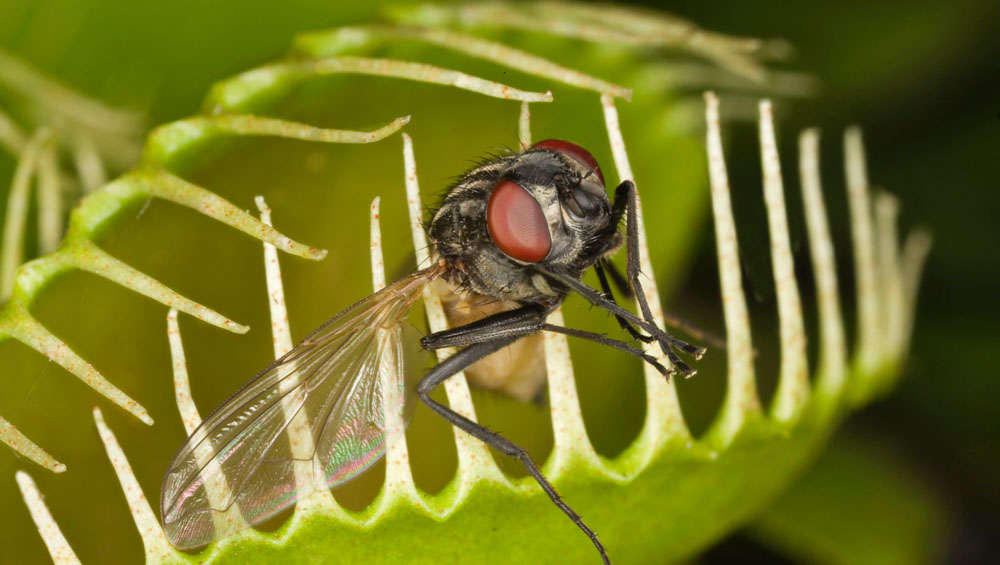Create a free profile to get unlimited access to exclusive videos, sweepstakes, and more!
Venus flytraps just got more terrifying because they generate magnetic fields with their vicious jaws

Are they plants or planets? Venus flytraps are still plants, but they can generate a magnetic field just by snapping their jaws shut over the next juicy and unsuspecting insect to land there.
When a Venus flytrap closes what at least appears to be a mouth full of green teeth, it will generate a magnetic field about a million times weaker than Earth’s. At least that is what scientists found after testing its patience. Anything with an electrical current is supposed to also generate a magnetic field (that includes humans) — this is biomagnetism. While the flytrap doesn’t zap dinner, what it does give off is thought to be a byproduct of electricity that flows through its jaw-like leaves, and has now given scientists more insight into the magnetic powers of plants.
“The idea was to start with a plant system that produces more "animal-like" signals. Venus flytraps offer this because they are one of the few plant systems in which sharp action potentials have been identified by biologists,” physicist Anne Fabricant, who led a study recently published in Scientific Reports, told SYFY WIRE. "Furthermore, the Venus flytrap system is very robust and can be stimulated by a variety of energy inputs—mechanical (touch), thermal (heat or cold), chemical (salt water), and electrical—all of which give rise to APs and subsequent trap closure."
Biomagnetism in plants has never really been well understood. Much more is known about this phenomenon in animals and humans, but Fabricant and her team studied action potential to find out how a magnetic field is generated by Venus flytraps when they want to feed. Impulses in the membrane of muscle or nerve cells can switch on a sudden change in electrical potential, and this change is an action potential (AP). Flies don’t stand a chance if they buzz into those jaws. When an insect accidentally stimulates any of the predator plant’s three trigger hairs by brushing up against them, that instantly sends an AP through both lobes of the trap.
Prey has 30 seconds to get away before its grim fate is decided. If the bug stimulates another one of those trigger hairs within that time, it will set off energy that closes the trap over it, and the flytrap’s digestive juices will start taking over. Venus flytraps can even grab a meal if their petioles, the stalks that join those trap leaves to the stem, are injured. The stalk is not electrically plugged into the trap, so the trap can function on its own so long as the plant is alive. It just needs stimulation from something to clamp down. The trap can even keep catching food if one lobe is injured, and may also be stimulated by a temperature change or too much salt in the atmosphere.
"It is believed that the AP propagates through the trap via electrically conductive phloem in the "parallel-vein" vasculature of the trap," Fabricant said. "This structure does not extend into the petiole below the trap, so each trap is effectively an independent electrical network. The AP propagates through a trap at speeds of around 10 m/s, which apparently is about how fast Usain Bolt can run."
Venus flytraps can generate as much of a magnetic field as nerve impulses in animals. The researchers needed to use heat instead of touch, because using touch to switch on APs can end up in background noise that screws up recordings of the electrical reaction. Sure enough, the temperature change made open traps snap shut. More drastic changes in heat influenced it to snap faster. This could be really bad news for insects flying lazily around these easily triggered plants in hot, humid environments that get even hotter during the summer.
After they were sure that heat could trigger a flytrap’s trap with an AP, Fabricant’s team searched for a magnetic field. Since the sensors of magnetometers are highly sensitive and could pick up on any other sort of magnetism that could interfere with measurements of what the plants generated, they stayed in a magnetically shielded room. Sensors watched both the plants and their surroundings. After cancelling out noise in the resulting data, researchers found that the magnetic and electrical signals from the flytrap have similar shapes, and that some things about the magnetic signal were associated with the AP that was fired off.
By seeing where a magnetic field spawned, they were also able to demystify how electrical signals spread throughout those jaws. Being able to measure a magnetic field in plants goes beyond just the hungry ones. Out of all the potential future uses for Fabricant's findings, there is one she believes is especially promising.
"We are particularly excited about the possibility of using magnetometers to perform noninvasive monitoring and diagnostics of various plant species in the same way this has already been done in humans and other animals, where magnetic techniques (such as MRI and MEG) have largely replaced electrode-based contact measurements of electrical activity," she said. "I hope that magnetic techniques could one day revolutionize agriculture in the same way they have revolutionized medicine."
And you thought Little Shop of Horrors freaked you out.


























